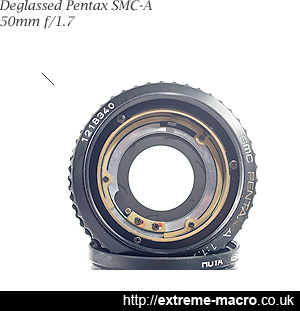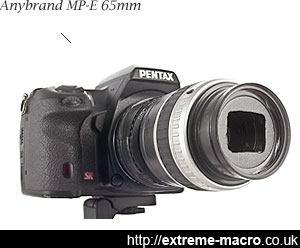The Empty Lens
by Johan J Ingles-Le Nobel
Last updated August 31, 2017
The empty lens is an unbelievably simple concept that I developed in 2012, to give better aperture control with reversed lenses.
Reversed Lenses In Use

Old Pentax-A 50mm f/1.7 used as empty lens, to control the aperture through the camera for another lens coupled against it. A thin lens with minimal distance between its diaphragm and the reversed lens would be better, but the thin lenses like the 40 pancake don't have f/1.7.
The big downside of using reversed lenses is that you cannot control their aperture through the camera.
In other words, with a reversed lens, in order to shoot at f/16, you need to set the lens to f/16. Grrrrrrr.
You cannot look through a wide open aperture and tell the camera to use f/16 on the reversed optic when taking the shot. This is pretty tough. This is why I usually advise people who are starting out in extreme macro to start out with Raynox adapters because using those avoids this problem.
At a magnification of 3:1 you're already experiencing light loss, so the image is already darker than you want it.
Stop the reversed lens down to f/16 as you need to because you don't have in-camera aperture control, and you see almost nothing.
Seeing almost nothing through the viewfinder really isn't all that great when you're trying to compose and focus. One solution is to mount a torch on your camera to light up your target, and I've tried this. Although it helps, you don't actually always shine a light into an insect, they tend to walk away or fly quite quickly. But there's another way...
Remove Lenses For Aperture Control
The anybrand MP-E 65mm extreme macro lens for Pentax uses old deglassed SMC-A 50mm f/1.7 empty lens with a reversed SMC Pentax FA 35-80 f4-5.6 coupled onto it with coupling adapter. It is an excellent value for money MP-E 65mm extreme macro lens substitute for my Pentax system.
There is a solution to this photography problem, and it is actually devastatingly simple. It costs very little time or money, all you need is a few tools to take a lens apart and a crappy lens from eBay.
The solution is the "empty lens", which is a working aperture-controlled lens with all the glass elements removed by hand.
Then use the empty lens as your extension tube and back your reversed lens onto this.
Remember, the empty lens can be the crummiest 3rd party lens, all you want it for is its aperture mechanism and the filter mount to reverse your lens onto.
Beware though, that you need a big enough image circle on your empty lens to show on your sensor. For example, on a 28mm f/2.8 the biggest diameter is 10mm (28/2.8) which may not be sufficient for full frame or APSC, but might suffice for 4/3 and smaller. Having not tried every combination I wouldn't want to misinform, but it's something to bear in mind.
Using the Empty Lens
The nearer that your aperture is to the reversed lens, the better out of focus areas you will get. By implication, set the lens to infinity focus.
On the plus side, doing this will at least give you aperture control from inside the camera, which is one of the main problems I personally have using reverse lens macro. Especially when the viewfinder is silly dark and you can't see a thing. On the minus side it's worth re-stressing that having the iris far away from the lens in front does lead to strange bokeh effects, so a better solution might be doing this with some old zoom lens that you're thinking of throwing away anyway, so that as you change the zoom (ie physical distance away from the sensor), the iris is always reasonably close to the lens in front. Ie almost a bellows with inbuilt aperture control. This is (still) sitting on that (endlessly growing) list of 'things to do some time in the future before I retire'; if anyone else has a play at doing this please do let me know the result!
Related Articles



